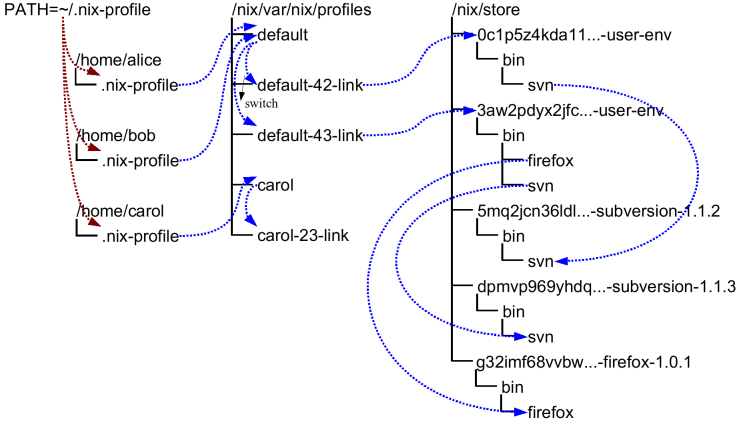# Profiles
Profiles and user environments are Nix’s mechanism for implementing the
ability to allow different users to have different configurations, and
to do atomic upgrades and rollbacks. To understand how they work, it’s
useful to know a bit about how Nix works. In Nix, packages are stored in
unique locations in the *Nix store* (typically, `/nix/store`). For
instance, a particular version of the Subversion package might be stored
in a directory
`/nix/store/dpmvp969yhdqs7lm2r1a3gng7pyq6vy4-subversion-1.1.3/`, while
another version might be stored in
`/nix/store/5mq2jcn36ldlmh93yj1n8s9c95pj7c5s-subversion-1.1.2`. The long
strings prefixed to the directory names are cryptographic hashes (to be
precise, 160-bit truncations of SHA-256 hashes encoded in a base-32
notation) of *all* inputs involved in building the package — sources,
dependencies, compiler flags, and so on. So if two packages differ in
any way, they end up in different locations in the file system, so they
don’t interfere with each other. Here is what a part of a typical Nix
store looks like:

Of course, you wouldn’t want to type
```console
$ /nix/store/dpmvp969yhdq...-subversion-1.1.3/bin/svn
```
every time you want to run Subversion. Of course we could set up the
`PATH` environment variable to include the `bin` directory of every
package we want to use, but this is not very convenient since changing
`PATH` doesn’t take effect for already existing processes. The solution
Nix uses is to create directory trees of symlinks to *activated*
packages. These are called *user environments* and they are packages
themselves (though automatically generated by `nix-env`), so they too
reside in the Nix store. For instance, in the figure above, the user